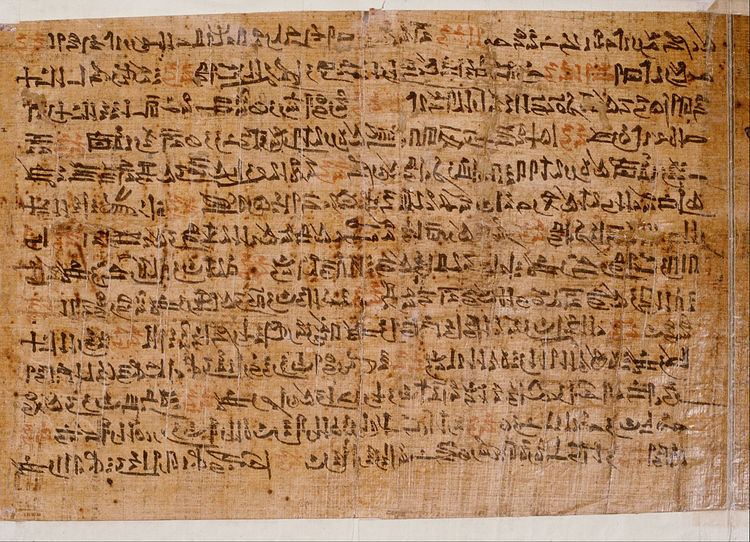 | ||
The Ipuwer Papyrus (officially Papyrus Leiden I 344 recto) is an ancient Egyptian hieratic papyrus made during the Nineteenth Dynasty of Egypt, and now held in the Dutch National Museum of Antiquities in Leiden, Netherlands. It contains the Admonitions of Ipuwer, an incomplete literary work whose original composition is dated no earlier than the late Twelfth Dynasty of Egypt (c.1991-1803 BCE).
Contents
Content
In the poem, Ipuwer – a name typical of the period 1850-1450 BCE – complains that the world has been turned upside-down: a woman who had not a single box now has furniture, a girl who looked at her face in the water now owns a mirror, while the once-rich man is now in rags. He demands that the Lord of All (a title which can be applied both to the king and to the creator sun-god) should destroy his enemies and remember his religious duties. This is followed by a violent description of disorder: there is no longer any respect for the law and even the king's burial inside the pyramid has been desecrated. The story continues with the description of better days until it abruptly ends due to the missing final part of the papyrus. It is likely that the poem concluded with a reply of the Lord of All, or prophesying the coming of a powerful king who would restore order.
Discussion
The Ipuwer Papyrus has been dated no earlier than the Nineteenth Dynasty, around 1250 BCE but it is now agreed that the text itself is much older, and dated back to the Middle Kingdom, more precisely the late Twelfth Dynasty.
It was previously thought that the Admonitions of Ipuwer presents an objective portrait of Egypt in the First Intermediate Period. In more recent times, it was found that the Admonitions, along with the Complaints of Khakheperresenb, are most likely works of royal propaganda, both inspired by the earlier Prophecy of Neferti: the three compositions have in common the theme of a nation that has been plunged into chaos and disarray and the need for an intransigent king who would defeat chaos and restore maat. Toby Wilkinson suggested that the Admonitions and Khakheperresenb may thus have been composed during the reign of Senusret III, a pharaoh well known for his use of propaganda. In any case, the Admonitions are not a reliable account to early Egyptian history, also because of the wide time interval between its original composition and the writing of the Leiden Papyrus.
The Admonitions is considered the world's earliest known treatise on political ethics, suggesting that a good king is one who controls unjust officials, thus carrying out the will of the gods. It is a textual lamentation, close to Sumerian city laments and to Egyptian laments for the dead, using the past (the destruction of Memphis at the end of the Old Kingdom) as a gloomy backdrop to an ideal future.
Ipuwer and the Book of Exodus
The archeological evidence does not support the story of the Exodus, and most histories of ancient Israel no longer consider it relevant. Nevertheless, Ipuwer has often put forward in popular literature as confirmation of the Biblical account, most notably because of its statement that "the river is blood" and its frequent references to servants running away. An extension of the same reading is the idea that both Ipuwer and the Book of Exodus are records of a volcanic eruption on the Aegean island of Thera. These arguments ignore the many points on which Ipuwer contradicts Exodus, such as the fact that its Asiatics are arriving in Egypt rather than leaving, and the likelihood that the "river is blood" phrase may refer to the red sediment colouring the Nile during disastrous floods, or may simply be a poetic image of turmoil.
